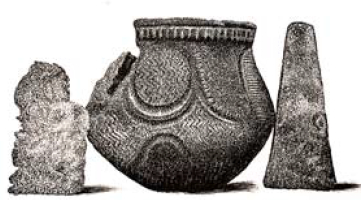|
The Toolesboro Dog-Paw Pot: A Unique Middle Woodland Vessel
|
by William Green |
| Central States Archaeological Societies 2020
October Journal |
Beloit, Wisconsin |
|
This excerpt from "The Toolesboro Dog-Paw
Pot: A Unique Middle Woodland Vessel" published in the 2020 Central States Archaeological
Societies 2020 October Journal
Read the complete column in the Central States
Archaeological Societies 2020
October Journal which can be purchased on-line after March 2021
|
|
|
Betty and Dale Roberts holding the Ted Watson Memorial
Award presented to them in 1971.
|
The Toolesboro Mound Group (13LA29) is a National Historic Landmark and
an Iowa State Preserve. It is situated on a bluff top overlooking the Mississippi
River valley at the mouth of the Iowa River. The five-acre site is owned
by the State Historical Society of Iowa, with the Louisa County Conservation
Board responsible for maintenance and interpretation. Two large, well preserved
mounds are easily accessible in a mowed, park-like setting (Fig. 1). Five
more mounds are present in the adjacent woods. An interpretive center is
staffed during limited hours between the Memorial Day weekend and the end
of October. Located in the small community of Toolesboro, 25 miles north
of Burlington on Iowa’s Great River Road (State Highway 99), the site
is worth a visit any time of year. Adjacent to the site is the Littleton
Brothers Memorial, a monument commemorating six local African American brothers
who died in the Civil War.

|
|
Figure 2. Image from Stevenson (1879)
showing copper sheet, pottery jar, and copper axe from Toolesboro.
|
|
|
|
|
|
|
While the Toolesboro State Historic Site preserves seven mounds, at least
13 more mounds once existed in a mile-long row on both sites of town. Those
mounds, an adjoining octagonal earthwork, and a large Oneota village site
(the McKinney site, 13LA1) attracted settlers’ attention from as early
as 1840. Local residents and archaeology enthusiasts from the Muscatine and
Davenport Academies of Science excavated many of the Toolesboro mounds in
the 1800s. In the 20th century, archaeologists affiliated with the Davenport
Public Museum (now Putnam Museum), University of Iowa, University of Illinois,
and Iowa Archeological Society worked at the mounds and at nearby sites in
and around Toolesboro.
The early mound excavators at Toolesboro were avid but untrained diggers.
Only a few scanty records exist from their work. Some of the artifacts they
found are housed at the Putnam Museum, but we do not know which specific
mounds most of the objects came from or what they might have been associated
with. We’re sure of one thing, though: almost every artifact recovered
is Middle Woodland in age.

|
|
Figure 4. Image from a stereo photo
showing the dog-paw decoration s on the vessel from Toolesboro.
|
|
|
|
|
|
|
The Middle Woodland period in eastern Iowa and western Illinois is best
known as the time when “Hopewell” flourished. Hopewell refers
to the networks and styles that connected many Middle Woodland societies
throughout eastern North America around 2000 years ago. Exotic and elaborate
objects and distinctive art styles characterize Hopewell material. Log crypts
covered by mounds were common parts of Hopewell burial programs. Many types
of elaborate Middle Woodland artifacts and tomb/mound burials actually appeared
around 200 BC, about 100 years before the classic Hopewell style emerged.
John E. Stevenson, an attorney, was one of the Muscatine Academy of Science
mound explorers. Stevenson excavated two mounds at Toolesboro in November
1878. Both mounds reportedy were 40 feet in diameter and about 5 feet in
height. Stevenson used a pick, among other tools, to dig the mounds, in which
he found bones, copper axes, a copper sheet and pottery. One pottery jar
was especially notable. Stevenson published an ...
Read the complete column in the Central States Archaeological Societies 2020
October Journal which can be purchased on-line after March 2021
|
|




